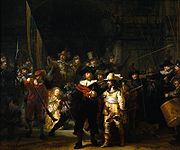
Frans Banning Cocq
Encyclopedia

Amsterdam
Amsterdam is the largest city and the capital of the Netherlands. The current position of Amsterdam as capital city of the Kingdom of the Netherlands is governed by the constitution of August 24, 1815 and its successors. Amsterdam has a population of 783,364 within city limits, an urban population...
in the mid-17th century. He is best known as the central figure in Rembrandt's masterpiece The Night Watch
Night Watch (painting)
Night Watch or The Night Watch or The Shooting Company of Frans Banning Cocq is the common name of one of the most famous works by Dutch painter Rembrandt van Rijn....
.
Cocq was the only son of an Amsterdam pharmacist. He studied law in France
France
The French Republic , The French Republic , The French Republic , (commonly known as France , is a unitary semi-presidential republic in Western Europe with several overseas territories and islands located on other continents and in the Indian, Pacific, and Atlantic oceans. Metropolitan France...
but returned to Amsterdam and became captain of the militia
Militia
The term militia is commonly used today to refer to a military force composed of ordinary citizens to provide defense, emergency law enforcement, or paramilitary service, in times of emergency without being paid a regular salary or committed to a fixed term of service. It is a polyseme with...
there. In 1630 he married Maria Overlander van Purmerland
Maria Overlander van Purmerland
Maria Overlander van Purmerland was a noble from the Dutch Golden Age.Maria Overlander was the daughter of Volkert Overlander and Geertruid Hooft. At the age of 27 she married Frans Banning Cocq. The couple lived at the house De Dolphijn and resided at their castle Ilpenstein. Jan Vos wrote a poem...
, the only surviving child of Volkert Overlander
Volkert Overlander
Volkert Overlander was a Dutch noble, jurist, ship-owner, merchant and an Amsterdam regent from the Dutch Golden Age.-Biography:...
, merchant, ship owner, knight, one of the founders of the Dutch East Trading Company
Dutch East India Company
The Dutch East India Company was a chartered company established in 1602, when the States-General of the Netherlands granted it a 21-year monopoly to carry out colonial activities in Asia...
and a few times burgemeester (mayor
Mayor
In many countries, a Mayor is the highest ranking officer in the municipal government of a town or a large urban city....
) of Amsterdam. When Volckert died, Banning Cocq inherited his properties north of Amsterdam along with the title Lord of Purmerland
Purmerland
Purmerland is a hamlet of 395 in the municipality of Landsmeer, North Holland, the Netherlands. It is located just north of Den Ilp and just south of the housing estate of Weidevenne, part of the city of Purmerend...
and Ilpendam
Ilpendam
Ilpendam is a village in the Dutch province of North Holland. It is a part of the municipality of Waterland, and lies about 4 km south of Purmerend.-History:The man standing highlighted at center on Rembrandts Night Watch painting is Frans Banning Cocq...
and lord of the castle of Ilpenstein
Ilpenstein
Ilpenstein was the name of a ruined castle of the Free and high Lordship of Purmerend, Purmerland and Ilpendam, located in Ilpendam in the north of the city of Amsterdam.-History:...
. In 1632 he became commissioner of a college and sometime around 1650 he was named burgemeester (mayor) of Amsterdam. He was also an advisor to his brothers in law Cornelis
Cornelis de Graeff
Cornelis de Graeff, also Cornelis de Graeff van Polsbroek was the most illustrious member of the De Graeff family. He was a mayor of Amsterdam from the Dutch Golden Age and a powerful Amsterdam regent after the sudden death of stadholder William II of Orange...
and Andries de Graeff
Andries de Graeff
Free Imperial Knight Andries de Graeff was a very powerful member of the Amsterdam branch of the De Graeff - family during the Dutch Golden Age. He became a mayor of Amsterdam and a powerful Amsterdam regent after the death of his older brother Cornelis de Graeff...
, and died around 1655. Banning Cocq's tomb chapel is located in the Oude Kerk.
Banning Cocq is known today primarily for a painting commissioned from Rembrandt van Rijn which shows Cocq and the company of civil guards he commanded. Although known as The Night Watch
Night Watch (painting)
Night Watch or The Night Watch or The Shooting Company of Frans Banning Cocq is the common name of one of the most famous works by Dutch painter Rembrandt van Rijn....
, this is not the original title; at that time it was in fact unusual to title paintings but if indeed it had a name, the more correct one would be "The Company of Captain Frans Banning Cocq and Lieutenant Willem van Ruytenburch". The painting is notable, among other things, for its huge size: approximately 3.35 m x 4.26 m (11 ft by 14 ft).

